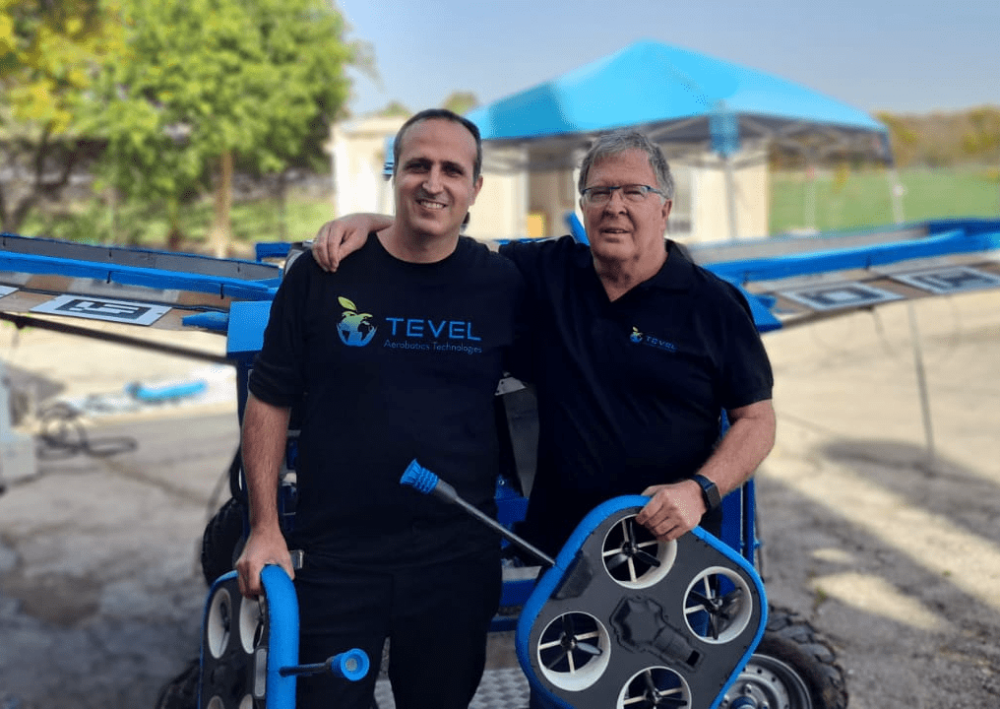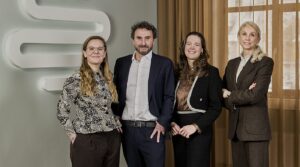Disclosure: AFN’s parent company AgFunder is an investor in Tevel.
“Right now there’s just not enough pickers to harvest fruit on time and farmers are just bleeding money, losing revenues and profits due to this global labor shortage,” says Danielle Efargan from Tevel, an Israeli developer of autonomous flying fruit-picking robots currently serving the European and US markets.
Tevel recently made headlines after being recognized as one of the winners in the ‘Top-10 New Product‘ competition at the World Ag Expo in Tulare, California.
Tevel’s founder and CEO Yaniv Maor, who comes from a background in research and development, industrial defense and consumer markets spanning over 20 years, had the idea for the company after watching a documentary where young people were tasked to manually pick fruit. In just half a day, everyone quit because the task was too strenuous. Apart from the strain, such labor is often priced very low in the market and is scarce. Manual harvesting is also one of the major causes of food waste due to unnecessary bruising and is very time inefficient.
Milestones after Tevel’s raise in 2021 include securing $20 million from a pool of investors including AgFunder, for product validation, commercialization, and commencing operations in the US and Europe. The robot maker’s market entry strategy is to partner with ag machinery and harvesting solutions manufacturers and integrate its robots and ground computing software system into these harvesting machines.

Partnering for milestones
Fast forward to 2023 and the ag robotics startup has established key partnerships with ag machinery manufacturers to serve the US and European markets where its robots have been in use since early 2022 and 2021, respectively.
Tevel’s first partnership is with machinery manufacturer S&S Metal Fabrication. Under the partnership, the two companies created ‘Alpha-Bot’, an autonomous harvesting system was released. ‘Alpha-Bot’ is able to selectively pick fruit and transmit real-time data on a fruit’s quality, its weight, size, color, whether it has been infected with a disease and at what time and from which tree it was picked. It is set to be used for apple and stone fruit picking in California for the fruit producer HMC farms. The system will also be deployed in operations in Washington.
Tevel’s second partnership is with Darwin Harvesting Group, an integrated fruit harvesting machinery manufacturer based in Italy where Tevel is serving fruit grower and distributor, Rivoira Group.
World Ag Expo prize
Winning the ‘Top-10 New Product’ competition at the World Ag Expo was also a recent accomplishment for Tevel. The company was one of the three Israeli companies among the 10 winners of the competition where it also had a chance to debut ‘Alpha-Bot’. This, Efargan says, is “the legitimization that our technology is needed and necessary, and it’s welcome in the California agricultural industry.”
Farmers have also shown much excitement for Tevel’s technology as the company claims to reduce a grower’s total costs by 20% to 30%. It also claims that its robots lower bruising rates and are better at selective picking than humans by 20% when it comes to gauging a fruit’s ripeness.
“We’re there to help prevent fruit waste and to help farmers stay in business. Farming is an incredibly difficult industry and farmers face so much risk and uncertainty, and their profit margins are razor-thin. We are there to help them drive their operations forward and to help them stay in business by making harvesting more efficient and reliable. Our robotic harvesting solution increases their profitability and ultimately helps to feed the world,” Efargan says.
With operations locked in, in the US and Italy, Tevel has set its eyes on expanding into France, South America, and New Zealand. Efargan adds that farmers more and more understand that robotics and automation is the only way for them to stay in business, and if they don’t start working towards integrating this technology into their operations, they’ll be left behind.

Image credit: Kelly Lambert



